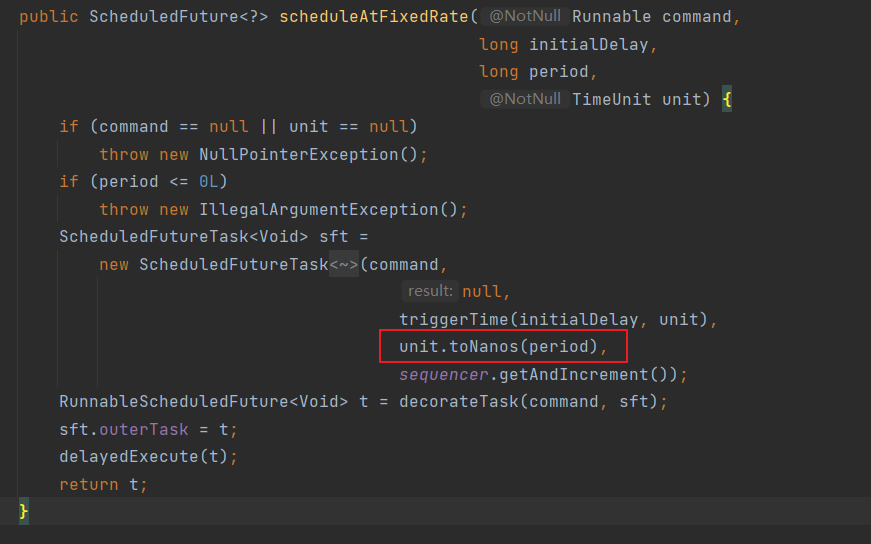ScheduledExecutorService中scheduleAtFixedRate方法与scheduleWithFixedDelay方法的区别
ScheduledExecutorService中scheduleAtFixedRate方法与scheduleWithFixedDelay方法的区别
ScheduledThreadPoolExecutor继承自ThreadPoolExecutor,可以作为线程池来使用,同时实现了ScheduledExecutorService接口,来执行一些周期性的任务。ScheduledExecutorService一般常用的方法主要就4个
public ScheduledFuture<?> schedule(Runnable command, long delay, TimeUnit unit)
public <V> ScheduledFuture<V> schedule(Callable<V> callable,long delay, TimeUnit unit);
public ScheduledFuture<?> scheduleAtFixedRate(Runnable command,long initialDelay,long period,TimeUnit unit);
public ScheduledFuture<?> scheduleWithFixedDelay(Runnable command,long initialDelay, long delay,TimeUnit unit);
两个schedule方法都很明确,就是执行一次Runnable、Callable任务。
scheduleAtFixedRate和scheduleWithFixedDelay这两个方法看起来就不是那么好区分了,今天就带大家从源码角度看看这两个方法的区别.
我们先看看这两个方法的区别
下面是这两个方法的源码


从上面的图上可以看到唯一的不同就是在创建ScheduledFutureTask对象的时候,scheduleWithFixedDelay将我们传入的delay取了个负数。所以这两个方法的区别都会在ScheduledFutureTask这个类中。
先说下ScheduledFutureTask这个类吧,它是ScheduledThreadPoolExecutor的内部类,我们看下它的继承关系

从上图中能看到ScheduledFutureTask,间接继承了Runnable接口,会实现run方法。而我们ScheduledThreadPoolExecutor类中真正执行任务的类其实也就是调用ScheduledFutureTask的run方法。也间接实现了Comparable接口的比较方法。
下面以scheduleAtFixedRate看看内部调用逻辑
public ScheduledFuture<?> scheduleAtFixedRate(Runnable command,
long initialDelay,
long period,
TimeUnit unit) {
if (command == null || unit == null)
throw new NullPointerException();
if (period <= 0L)
throw new IllegalArgumentException();
ScheduledFutureTask<Void> sft =
new ScheduledFutureTask<Void>(command,
null,
//这里是计算首次执行实现
triggerTime(initialDelay, unit),
unit.toNanos(period),
sequencer.getAndIncrement());
//这里当前是直接返回的上面的sft,这个是留给子类去扩展的
RunnableScheduledFuture<Void> t = decorateTask(command, sft);
sft.outerTask = t;
//所以这里也就是把上面创建的ScheduledFutureTask加到线程池的任务队列中去
delayedExecute(t);
return t;
}
这里是ScheduledFutureTask的构造方法
ScheduledFutureTask(Runnable r, V result, long triggerTime,
long period, long sequenceNumber) {
super(r, result);
//这个是任务首次执行的时间
this.time = triggerTime;
//这里的代码很简单,只是将它赋值给了成员变量period。
//其中scheduleWithFixedDelay是在外面取了个负数传了进来,scheduleAtFixedRate则是原样传了进来
this.period = period;
//这个是AtomicLong类型的,每次都+1,对我们加入的任务做了个编号
this.sequenceNumber = sequenceNumber;
}
我们再看看
delayedExecute(t);的内部private void delayedExecute(RunnableScheduledFuture<?> task) {
if (isShutdown())
reject(task);
else {
//重点在这里,这里会把上面的ScheduledFutureTask加入到线程池的任务队列中,
//这里的super.getQueue()这个队列,是在ScheduledThreadPoolExecutor构造方法中定义的,也是ScheduledThreadPoolExecutord的内部类,类名是DelayedWorkQueue
//DelayedWorkQueue其实是一个最小堆,会对加入它的元素,调用compareTo方法进行排序,首个元素是最小的
//对应当前这里,就是调用ScheduledFutureTask的compareTo方法进行排序,也就是队列中的任务是按照执行时间的先后顺序排序的
//最终线程池执行任务的时候从首部依次获取task,具体获取任务的时候,DelayedWorkQueue会首先获取任务,查看对应的执行时间,如果任务时间没有到,就会调用Condition.awaitNanos去暂停,直到到达执行时间或者通过给队列中添加任务调用Condition.signal去唤醒
super.getQueue().add(task);
if (!canRunInCurrentRunState(task) && remove(task))
task.cancel(false);
else
//这里是根据线程池当前的线程数,如果小于核心线程数,就会新启动线程去执行任务
ensurePrestart();
}
}上面已经可以看到把任务已经加到线程池中去了,后面就是具体由线程池去执行任务了,所以我们直接去ScheduledFutureTask查看run方法就可以了
public void run() {
if (!canRunInCurrentRunState(this))
cancel(false);
else if (!isPeriodic())
super.run();
//具体在这里会调用我们传入的run方法
else if (super.runAndReset()) {
//在这里会更新成员变量time,scheduleAtFixedRate和scheduleWithFixedDelay的区别也全在这里了,下面我们去看看这里
setNextRunTime();
//这里会重新将outerTask加入到线程池的任务队列中,这里的outerTask==我们当前执行run方法的对象this
reExecutePeriodic(outerTask);
}
}
}
通过上面的代码也能看到,我们的run方法是不会同时由多次执行的,举个例子,如果我们调用scheduleAtFixedRate或者scheduleWithFixedDelay方法,传入的Runnable的对象,需要执行10s,而我们设定的周期是2s,是不会在第一次Runnable的10s的周期任务启动后2s,就启动第2次周期任务的。它只会在第一个Runnable的10s的周期任务结束后,重新加入到任务队列中之后,才会启动下次的任务。
private void setNextRunTime() {
//这里的period ,scheduleAtFixedRate传入的是正数,scheduleWithFixedDelay传入的是负数
long p = period;
if (p > 0)
//所以scheduleAtFixedRate会走这里,这里的time开始时时首次任务的开始执行时间,所以下次任务的时间就是(开始添加任务时计算出来的首次任务执行时间(这个时间不一定是任务首次执行的真正时间)+(任务执行次数-1)*period)
time += p;
else
//这里对p取负,就会还原成正数,也就是我们最初调用scheduleWithFixedDelay时传入的值,这里的下次执行时间会用当前系统时间(可以看成当前Runnable执行的结束时间)+period来设置
time = triggerTime(-p);
}
结论
scheduleAtFixedRate或者scheduleWithFixedDelay对于从第2次开始的任务的计算时间不一样:
- scheduleAtFixedRate 下次任务的时间=(开始添加任务时计算出来的首次任务执行时间+(任务执行次数-1)*period
- scheduleWithFixedDelay 下次任务的时间=当前任务结束时间+period
需要注意的是,下次任务时间都只是计算出来的理论值,如果任务的执行时间大于周期任务的period,或者设置的线程池中线程太少,就会出现下次任务执行时间<时间任务执行时间
最新文章
- 【转】Description Resource Path Location Type Java compiler level&n
- 关于each
- python IDE
- 使用XML文件和Java代码控制UI界面
- flexbox in IE (10+ and 9 and 8)
- Android.mk中添加宏定义
- PostgreSQL Hardware Performance Tuning
- final修饰符,finally,finalize区别
- MVC同一个视图多个submit对应不同action
- No setter found for property 'userDAO' in class 'com.ssh.service.impl.User1Service'
- Oracle11g R2学习系列 之十 解决EM不能用
- SQL SERVER——CPU问题定位与解决
- 记录一则enq: TX - row lock contention的分析过程
- [LeetCode] Add One Row to Tree 二叉树中增加一行
- Python 正则表达式 flags 参数
- 【原】Java学习笔记022 - 字符串
- 第二节,mnist手写字体识别
- [svc][jk]磁盘的iops和吞吐量(Throught)指标
- XP远程桌面连接2008提示:远程计算机需要网络级别身份验证,而您的计算机不支持该验证
- C++调用C代码的两种方式